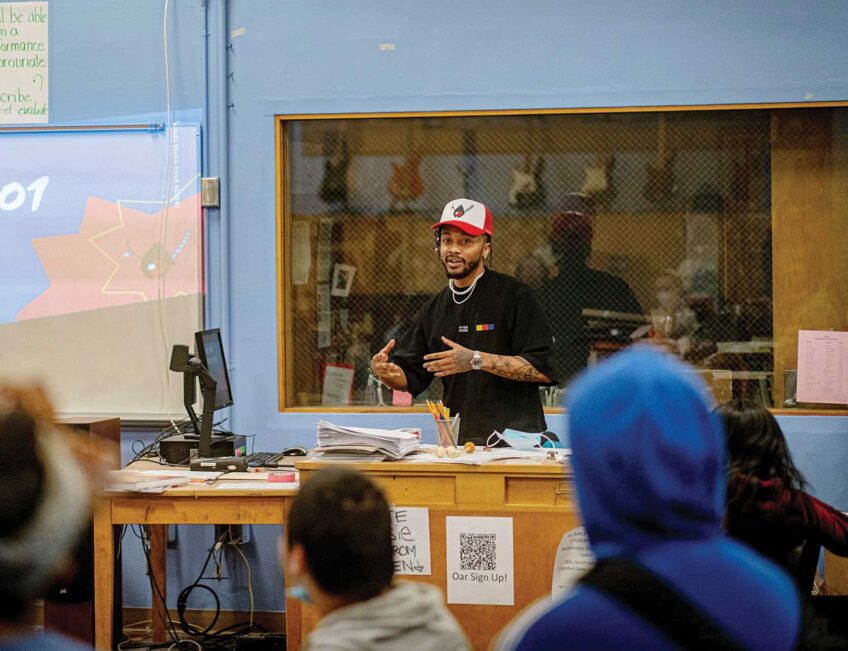
Immigrant teens are being detained and deported based on unsupported claims of gang membership, according to a report released last week by a national immigrant advocacy group. Claims of gang membership, whether they’re made by police, school officials or the immigration officials themselves, are often based on hearsay, but can carry serious consequences for teens, many of whom lack legal representation as they face deportation proceedings.
The increased use of the gang label comes as President Donald Trump has sought to link the rise in unaccompanied minors entering the United States with gang activity, most notably from MS-13, a largely Salvadoran gang active in Central America and some U.S. cities. The report, authored by the Immigrant Legal Resource Center, cites Trump’s rhetoric as a major factor in the increased detentions and deportations of Latino youths.
The report found that immigration officials across various Homeland Security agencies are falsely accusing immigrant youth of gang involvement and subsequently denying them immigration benefits, deporting or detaining them. Gang-related convictions make immigrants ineligible for various forms of relief from deportation, and can increase their probability of detainment while their immigration cases are pending, thereby making deportation orders harder to fight. Also, since most processes to obtain lawful permanent residence rely on the judge’s discretion, a gang allegation can be cause enough for a deportation ruling.
Ivan Espinoza-Madrigal, executive director of the Lawyers’ Committee for Civil Rights and Economic Justice, said the trend has shown up in immigration cases in Boston.
“We have seen this disturbing pattern emerge [in Boston] over the last few months,” he said. “And we have found instances where school records are being shared with law enforcement and immigration officials. In that manner, the schools are contributing to a disturbing school-to-prison-to-deportation pipeline.”
The lack of clarity in what constitutes gang involvement in immigration law along with unclear rules of evidence in immigration proceedings also allow for unsubstantiated claims of supposed gang affiliation, the report found. Vague definitions of gang-affiliated clothing are enough to label a student a gang member.
An immigrant youth wearing a Chicago Bulls hat, Nike Cortez sneakers, Michael Jordan shoes or shorts or the colors blue or red — all supposed signs of gang affiliation — could be classified as a gang member. Any contact with other suspected gang members, regardless of whether the contact was voluntary or forced, can be classified as gang affiliation. In some cases, even victims of gang violence are labelled gang members, because law enforcement suspects they were targeted due to their involvement in a rival gang.
In addition, any allegation of gang affiliation detailed in a school incident report, police report or other formal document can be used as grounds for suspected gang affiliation, even if the allegations are not substantiated.
These claims can make their way to gang databases, where students can be labeled as gang members or affiliates. That information can then be accessed by law enforcement. The lack of clear parameters for gang involvement or affiliation and lack of standards for admissible evidence of gang affiliation in court make the jobs of immigration attorneys nearly impossible.
When pictures of defendants wearing clothing labeled as gang-affiliated are used as evi-dence in court, often the source of the information is not disclosed, and the immigration attorney cannot determine whether the author has the expertise to make such a classification. The accused immigrants are then left to prove a negative — that they are not affiliated with a gang — and this burden of proof is nearly impossible to meet.
Espinoza-Madrigal points to a 2016 case where a minor confrontation in a Boston school ultimately led to the deportation of one of the students involved, who entered the United States illegally from El Salvador in 2014.
The student may have come to the attention of immigration authorities after school officials filed an incident report which was logged into the Boston Regional Intelligence Center (BRIC), a data analysis unit at the BPD which can be accessed by state and federal law enforcement, including U.S. Immigration and Customs Enforcement (ICE). Incident reports such as the one filed in this case are considered police reports and are shared with police if the situation is serious, but the confrontation detailed in this report was not violent. The student was labeled as a gang associate in the report and was later picked up by ICE, where he was denied bond, likely because of his suspected gang affiliation.
Espinoza-Madrigal said the Lawyer’s Committee is working with city and school officials to help protect immigrants from unwarranted scrutiny from immigration officials.
“We have been in communication with the city and Boston Public Schools to remedy the process that they follow to document these incidents to make it more robust and less careless, and also to make sure that information is only being shared with appropriate officials,” he said. “There’s no reason that a simple school incident report should make its way to police or immigration officials.”






